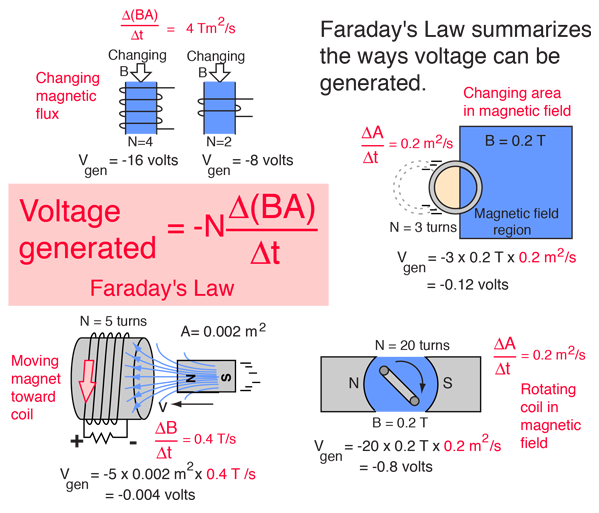
The rim thus becomes an electromagnet that resists rotation of the disc (an example of Lenz's law). When the generated current flows through the conducting rim, a magnetic field is generated by this current through Ampère's circuital law (labelled "induced B" in the figure). Mechanical work is necessary to drive this current. In the Faraday's disc example, the disc is rotated in a uniform magnetic field perpendicular to the disc, causing a current to flow in the radial arm due to the Lorentz force. A different implementation of this idea is the Faraday's disc, shown in simplified form on the right.
MAGNETIC FLUX EQUATION GENERATOR
For example, the drum generator is based upon the figure to the bottom-right. If the wire is connected through an electrical load, current will flow, and thus electrical energy is generated, converting the mechanical energy of motion to electrical energy. When a permanent magnet is moved relative to a conductor, or vice versa, an electromotive force is created. The EMF generated by Faraday's law of induction due to relative movement of a circuit and a magnetic field is the phenomenon underlying electrical generators. The principles of electromagnetic induction are applied in many devices and systems, including: This was one of the principal paths that led him to develop special relativity. Īlbert Einstein noticed that the two situations both corresponded to a relative movement between a conductor and a magnet, and the outcome was unaffected by which one was moving. This is believed to be a unique example in physics of where such a fundamental law is invoked to explain two such different phenomena. James Clerk Maxwell drew attention to the separate physical phenomena in 1861. It is one of the four Maxwell's equations, and therefore plays a fundamental role in the theory of classical electromagnetism.įaraday's law describes two different phenomena: the motional EMF generated by a magnetic force on a moving wire (see Lorentz force), and the transformer EMF this is generated by an electric force due to a changing magnetic field (due to the differential form of the Maxwell–Faraday equation). Theory Faraday's law of induction and Lenz's law Lenz's law gives the direction of the induced EMF and current resulting from electromagnetic induction. In 1834 Heinrich Lenz formulated the law named after him to describe the "flux through the circuit". Heaviside's version (see Maxwell–Faraday equation below) is the form recognized today in the group of equations known as Maxwell's equations. In Maxwell's model, the time varying aspect of electromagnetic induction is expressed as a differential equation, which Oliver Heaviside referred to as Faraday's law even though it is slightly different from Faraday's original formulation and does not describe motional EMF.

An exception was James Clerk Maxwell, who used Faraday's ideas as the basis of his quantitative electromagnetic theory. However, scientists at the time widely rejected his theoretical ideas, mainly because they were not formulated mathematically. įaraday explained electromagnetic induction using a concept he called lines of force. For example, he saw transient currents when he quickly slid a bar magnet in and out of a coil of wires, and he generated a steady ( DC) current by rotating a copper disk near the bar magnet with a sliding electrical lead (" Faraday's disk"). Within two months, Faraday found several other manifestations of electromagnetic induction. This induction was due to the change in magnetic flux that occurred when the battery was connected and disconnected. He saw a transient current, which he called a "wave of electricity", when he connected the wire to the battery and another when he disconnected it. He plugged one wire into a galvanometer, and watched it as he connected the other wire to a battery.

Based on his understanding of electromagnets, he expected that, when current started to flow in one wire, a sort of wave would travel through the ring and cause some electrical effect on the opposite side. In Faraday's first experimental demonstration (August 29, 1831), he wrapped two wires around opposite sides of an iron ring or " torus" (an arrangement similar to a modern toroidal transformer). It was discovered independently by Joseph Henry in 1832. Įlectromagnetic induction was discovered by Michael Faraday, published in 1831. Change in the magnetic flux of the left coil induces a current in the right coil. A diagram of Faraday's iron ring apparatus.


 0 kommentar(er)
0 kommentar(er)
